Moon - Tsadi
In her passive mode, Luna is the moon princess presiding over a scene of two canines that are facing each other. Each is flanked by a bastion. Beneath the two canines is a large body of water that is inhabited by a single crustacean. A patch of dry earth appears in front and behind the creature.
The name of the 18th character of the ancient alphabet is linked to the 18th hieroglyphic symbol of the Tarot. The original design of this character (pre-1200 B.C.) looks like this...
![]()
The passive nocturnal currents of the moon goddess are identified by the name of the 18th letter of the ancient alphabet, which is the sibilant (for which there is no English equivalent) that is referred to in the ancient texts by the word צדי, which is derived from the biliteral root that consists of the letters Tsadi and Daleth/D. This root has the basic meaning of “side” as is obvious in the word's etymology. From this basic idea, the word also means "to oppose" in the sense of taking sides in a conflict. From this definition, the word recieves its modern day usage of "to hunt." When used by itself, this letter has also been employed in the ancient texts to represent the idea of “shining.” This specific meaning of shining is inherent due to the fact that it is a sibilant, and all of the sibilants contain this primitive etymological representation in their essence.
Therefore, the left-handed currents of the energy expressed by this hieroglyph are expressed by the letter whose name means “side.” In the Masoretic texts, the left side is generally implied with most usages of this term. The lunar hieroglyph that expresses the passive left-sided frequencies shows two canines howling at the moon, one on each side of the heavenly body, as the waters of the tidal flow manifest themselves into the passive currents of the reality of Mother Nature's ever flowing heartbeat.
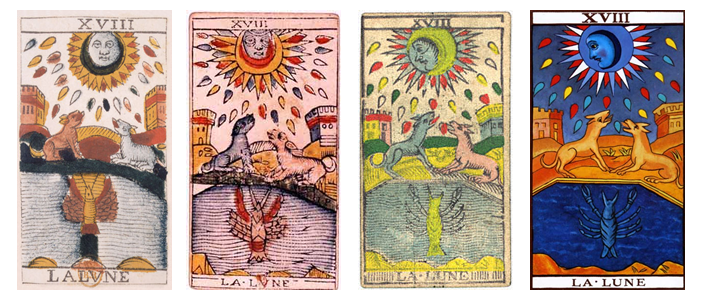
The Lobster
The single lobster in the pond at the bottom of this hieroglyph could then be seen as a biological life form on Terra's surface that would be more intimately associated with the tidal pull of Luna. This would obviously be because crustaceans would feel the drag of the tidal currents with their legs more than the fish and other swimming creatures that maneuver freely in the water without the constant contact with the earth's surface. Thus, their brains and nervous systems would be acutely sensitive to the tidal ebb and flow that is inherent in all of the bodies of water upon the surface of Terra. So then the passive flow of Luna's silvery substance would be a very highly influential factor in the lives of these creatures, moreso than any other animal on the planet.
So then, the true essence of the negative female frequencies of Luna would be that type of emotional friction that causes disagreements between opposing factions. This type of negative motion is what fuels the tidal waves and tsunamis of human civilization and brings great wars. By understanding the currents of the sea, it becomes easier to better fathom the true nature of the depths of humanity's conflicts and struggles. By understanding the pull of the tides, one becomes more effective at dealing with these perturbing struggles.
The Moon of Rider-Waite
In his pictorial key to the Rider-Waite Tarot, Waite gives his description of this Colman illustration and states, “The distinction between this card and some of the conventional types is that the moon is increasing on what is called the side of mercy, to the right of the observer. It has sixteen chief and sixteen secondary rays. The card represents life of the imagination apart from life of the spirit. The path between the towers is the issue into the unknown. The dog and wolf are the fears of the natural mind in the presence of that place of exit, when there is only reflected light to guide it.
The last reference is a key to another form of symbolism. The intellectual light is a reflection and beyond it is the unknown mystery which it cannot shew forth. It illuminates our animal nature, types of which are represented below – the dog, the wolf and that which comes up out of the deeps, the nameless and hideous tendency which is lower than the savage beast. It strives to attain manifestation, symbolized by crawling from the abyss of water to the land, but as a rule it sinks back whence it came. The face of the mind directs a calm gaze upon the unrest below; the dew of thought falls; the message is: Peace, be still; and it may be that there shall come a calm upon the animal nature, while the abyss beneath shall cease from giving up a form.”
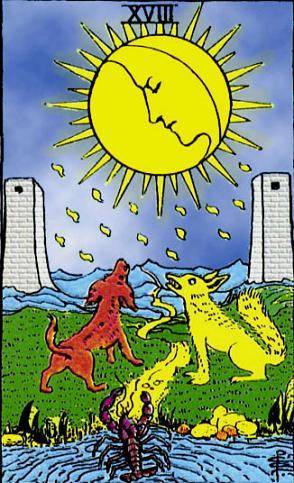
As Waite mentions in the above text, the heavenly body located at the top of image is increasing on the right side. In the Noblet version of this trump, the moon is increasing at its upper portion. In the many versions of the Marseilles Tarot that follow the Noblet version, there are many that depict the increasing on the right and the top. The moon at the top of this image could also be been as a lunar eclipse depending on which side the increasing portion occurs. It is important to bear in mind that the images of the hieroglyphs themselves might easily predate the any of the linguistic designations that have been applied to them within the last few centuries or so. Therefore, the trump referred to as “La Lune” might have had a completely different title at some point in its very distant past, if certain speculations are to be believed.
Another key distinction by Waite is that the two creatures are a dog and a wolf; however, when compared to the images of the Noblet Tarot and other later versions, it is uncertain whether the canine creatures of the image are either domesticated dogs, wolves, foxes, or another mixture thereof. It is highly interesting that this version of the trump places the dog on the left of the image and the wolf on the right – that is, assuming that the canine with the thicker, fluffier tail is the wolf. One would expect the opposite, especially since the right side of the increasing moon is mentioned at the beginning of his description of this trump; however, the wolf is on the left side of the moon, so the basic essence of this trump remains intact if it is examined from this perspective.
All things considered, however, what is arguably the most important notion presented in this image is a unique trait that is only found in the Noblet Tarot and absent in any of the later versions of the Marseilles Tarot, and that is the dry land that the shellfish upon which the shellfish stands that divides the waters. There is, of course, the lone bastion and the representative canine beast for each side of the water that has been divided. This aspect of the image is, however, recreated in the Rider-Waite version although it is transformed and depicts this division of dry land as a path that begins at the edge of the water and land between the two canines and continues until it disappears over the horizon. This is a crucial distinction, because this aspect is found only on the Noblet version and adds a completely new dimension to the aspect of the “shellfish in the water” portion of the image.
What this patch or path of dry land in the center of the water does is extend the original definition of the name associated with the 18th letter of the ancient alphabet and the 18th trump of the Tarot. The definition of the word צדי is now extended to the body of water at the bottom of the image as well. With all of the later versions of the Marseilles Tarot and the Rider-Waite Tarot, this distinction does not occur, and the body of water in which the shellfish resides is a united whole. With this crucial distinction made by the Noblet version and the Noblet version alone, the shellfish now becomes the sole mediator of the earthly realms that stands between the two opposing sides and either unites or divides them. Thus, the lobster is the spokesman for the moon.
* * *
BACK * INDEX * NEXT
 |
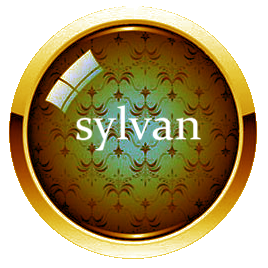 |
 |
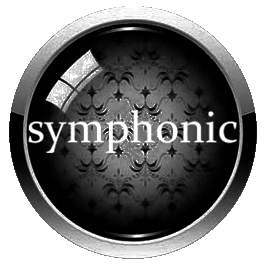 |
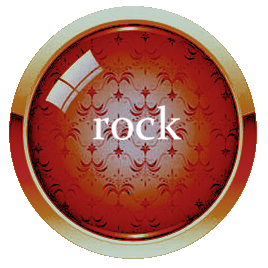 |
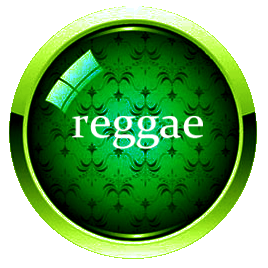 |